Saturn
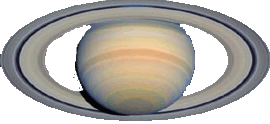

The planet Saturn is named after the Roman god of time, greenery and old age, ruler of Saturday, bringer of death.
The Finnish god Väinämoinen was a similar deity but he was also god of music and represented in the sky as the constellation of Orion.
In Chinese mythology, the planet was The Exorcist and his ruling element (there were five elements) was Earth, and Direction (or the cardinal point that the planetary deity ruled) was the Centre.
The Indian god of time was Kala, and was also the planet Saturn, and the Reaper and Bringer of Death.
In Siam, now Thailand, Saturn was Phra Sao, the Father of the Gods, whose whose wrath will cause terrible misfortune. Prayers are due to him when he approaches your Zodiacal sign, and it is advisable to perform sacrifices. Phra Sao can humble the proud. Only he can cause the fall of tyrants. He is the God of fickle fortune.
In Greek legends, the planet Saturn, was called Kronos or Chronos, after the God of Time, who castrated his father Uranus god of heaven. Thus separating him from his wife Gaia, the Earth, setting the heavenly bodies in motion and beginning the ordered rule of time. This story is similar to Polynesian legends telling of the separation of heaven and earth.
The Golden Age ruled by Time, is past as Chronos was overthrown and chained up by his son Zeus (Jupiter). Chronos knew this was going to happen, so to try and prevent it, he swallowed his children as soon as they were born To prevent this happening to yet another child, when Zeus was born, his mother substituted a stone which Chronos swallowed instead.
Saturn was seen by the Romans as an old man dressed in a shroud, wrapped in clanking chains and carrying a scythe. They celebrated his festival, the Saturnalia, at the winter solstice. Part of this festival was to create misrule and disorder, for example, employers attended upon their staff, at the celebratory feast. Many features of the Roman Saturnalia, survived in European traditions for Midwinter and Christmas and New Year celebrations.
Chronos (or Saturn) not only represented time, but also the metal - lead, the colour - black, a 6 -sided geometric shape, the number - 9, and was the ruling deity of the first hour and therefore the day of Saturday.
Each of the Roman hours of the day were presided over by a god representing one of the seven planets (which included the Sun and Moon, but not the Earth), and each of the seven days of the week began with an hour named after a different planet. From this comes the names of the days of the week in most European countries. In England, some of the Roman gods and goddesses were replaced by their Saxon equivalents. In Japan the days of the week are also named after the same planets.
 On astronomical tables this symbol was used for Saturn.
On astronomical tables this symbol was used for Saturn.
Saturn was believed to be the outermost of the planets. It orbits the Sun in 29.65 years, so observatories compiling new tables had to expect to function for at least thirty years, to produced a new and definitive set of tables for astronomers to use for many years. (Although the planet Uranus, beyond Saturn, could and may have been observed, it was probably not recognised as a planet, as its orbit of 84 years was beyond the working lifetime of any observer.)
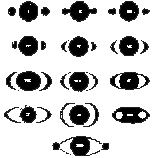 When Galileo and other astronomers looked through their new telescopes at the beginning of the 17th century Saturn looked very strange.
When Galileo and other astronomers looked through their new telescopes at the beginning of the 17th century Saturn looked very strange.
In 1656 Dutch astronomer Christiaan Huygens (1629-1695) discovered that the odd observations of his predecessors as shown in the picture, were rings around Saturn.
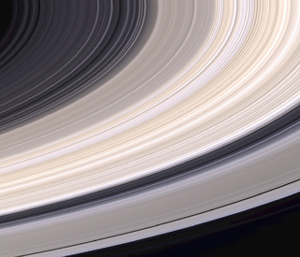
All the gas giants have them, but Saturn's are the biggest. More recently it was discovered that the rings are made of the debris, rocks (mostly about the size of cars) and dust, of satellites that have broken up.
The rings are very flat and thin, no more than one kilometre thick. If you made a model of Saturn and its rings with a ball and a sheet of paper no thicker than this, the ball would have to be 200 feet across and the rings 500 feet, to get an accurate model of the thickness of the rings in comparison with their width.
 The gravity of nearby satellites affects the rings making waves. By studying these waves it was possible to calculate the amount of material in the rings. If this was all squeezed together it would be the size of one of Saturn's smaller moons.
The gravity of nearby satellites affects the rings making waves. By studying these waves it was possible to calculate the amount of material in the rings. If this was all squeezed together it would be the size of one of Saturn's smaller moons.
The orbits of the rings are marked by larger pieces - tiny satellites, which are called 'shepherd satellites' as the rings of smaller particles are effectively kept within their orbits. This leaves gaps in the rings. Such a gap was first discovered by Cassini after whom the Cassini space probe was named. It was through such a gap that the Cassini space craft was able to slip safely through into orbit around Saturn on 1st July 2004. The photo shows the view as it went through.
Cassini is finding out more about the formation of Saturn's rings.
Probes to the outer Solar System in the 1970s and 1980s, especially Voyager 2, gave valuable new information about the four large outer planets, of which Saturn is the second in distance from the Sun. They are now called 'gas giants' and are really small stars, that is 'failed stars' - too small to be hot enough for nuclear fusion to take place. Each of the "gas giants" has its own "solar system" of satellites, some as large as the inner rocky planets, Mercury and Mars, although with lower densities.
Saturn has a diameter of 120.536 kilometres across its equator and a density of 0.7 - that is only two thirds that of water (which is 1) - so it must be nearly all gas, since the heat at its core will keep the higher density material as a gas.
The inclination of its axis in 29 degrees. The winds on Saturn gust at more than 1,800 kilometres an hour (or 1,100 miles per hour). They form bands of mainly orange and yellow clouds around Saturn with whirling stormy vortices and pale storm spots. There is some mystery about Saturn's rotation speed about its axis - which is very much faster than Earth at just over 10 hours - the exact speed as recorded by Voyager was faster than that recorded by the Cassini space craft. You can hear it and get more information.
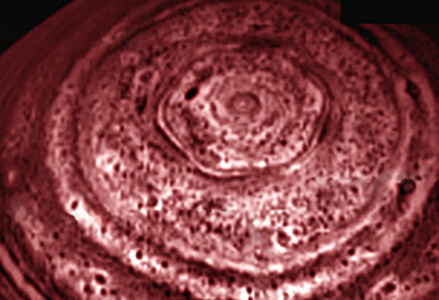
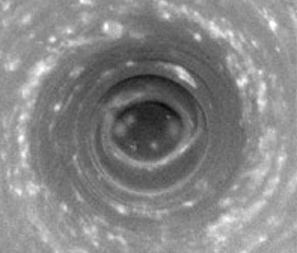
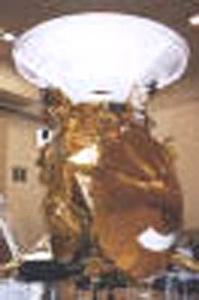
| Cassini to Saturn is the last of the major NASA projects in the traditions of Pioneer, Voyager and Galileo. With the cold war over, NASA could no longer depend on substantial government funding. We had the opportunity of seeing the Cassini probe in its hanger at the JPL Pasadena, just before it was to be taken to be launched. The Cassini spacecraft was launched on Oct. 15, 1997 targeted and arrived at Saturn July 2004. See how it is doing now.
|
Parts of Cassini:
| 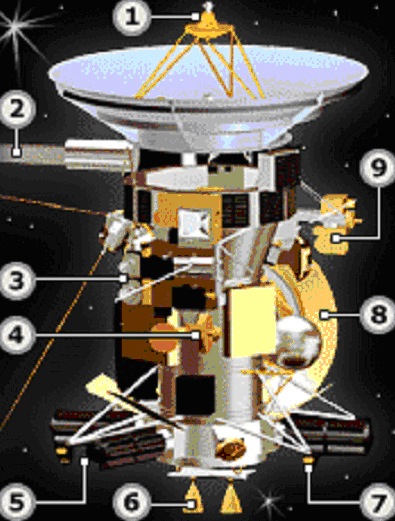 |
Parts of Huygens Probe:
|
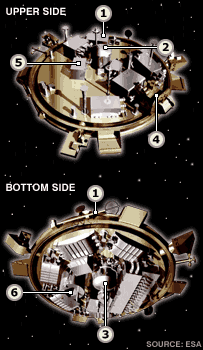 |
In order to save fuel on its long journey to Saturn, Cassini made several planetary flybys to get speed boosts by stealing a little orbital energy from the planets. It flew by Venus twice, then back around Earth, in 2000 it passed Jupiter. November 2002, it took a nice photo of Saturn as it approached.
It is now in orbit around Saturn - having slipped through a gap in the rings on 1st July 2004.
Xmas, 2004, the Huygens probe ejected from Cassini, parachuted through the atmosphere of Saturn's largest moon, Titan and landed safely on its surface on 14th January 2005 and sent back pictures and data.
Update on Cassini mission and Huygens probe.
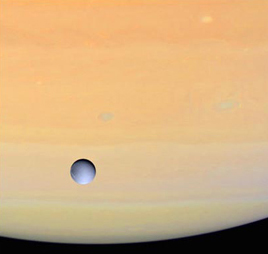
Saturn has very many satellites, 60 now counted and more being discovered and named. They are mostly of rock and ice with a density about half that of Earth's.
Here are the moons named so far:
Pan, Atlas, Prometheus, Pandora, Epimetheus, Janus, Mimas, Enceladus, Tethys, Telesto, Calypso, Dione, Polydeuces, Helene, Rhea, Titan, Hyperion, Iapetus, Phoebe, Paaliaq, Siarnaq, Tarvos, Kiviuq, Ijiraq, Thrym, Skadi, Mundilfari, Erriapo, Albiorix, Suttung, S/2003 S1. (the sort of number a moon gets until it has a name)Methone, Pallene, Ymir, S/2005, S1.
Here is some more information about Saturn's moons:
 discovered 1655. The largest of Saturn's satellites at 2575±2 kilometres radius - larger than the planet Mercury, only slightly smaller than Mars. But much less density at 1.88. (The inner planets are all around 5). Titan has a synchronous rotation round Saturn, it rotates once in the same time it takes to orbit Saturn.
discovered 1655. The largest of Saturn's satellites at 2575±2 kilometres radius - larger than the planet Mercury, only slightly smaller than Mars. But much less density at 1.88. (The inner planets are all around 5). Titan has a synchronous rotation round Saturn, it rotates once in the same time it takes to orbit Saturn.Titan is interesting, for not only is it the size of a planet, it has a thick atmosphere, ten times the mass of the Earth's atmosphere, which is mainly nitrogen like the Earth's. There are many chemical reactions going on in the atmosphere of Titan, and the resulting compounds form a layer of orange photochemical smog screening the surface from view.
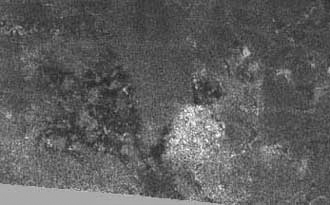 Cassini is able to see surface features on Titan using radar. The picture shows features seen end October, which look like a cat. Also seen is that the thick atmosphere is in bands parallel to the equator and has changing clouds.
Cassini is able to see surface features on Titan using radar. The picture shows features seen end October, which look like a cat. Also seen is that the thick atmosphere is in bands parallel to the equator and has changing clouds.
The surface temperature of Titan at -180°C is near the triple point of methane. At a triple point, a substance can be gas, liquid or solid. The atmosphere of Earth early in its history, some four thousand million years ago may have been similar to the present atmosphere on Titan, and study of the chemical processes on taking place on Titan might give clues to the formation of life on Earth.
| The Huygens probe arrived at Titan 14th January 2005. What look like river channels in this picture are not produced by running water but liquid methane. The rain is methane too. It seems the methane comes from icy volcanos and the methane rivers dry out eventually. There are methane seas and lakes but they may not be permanent. |
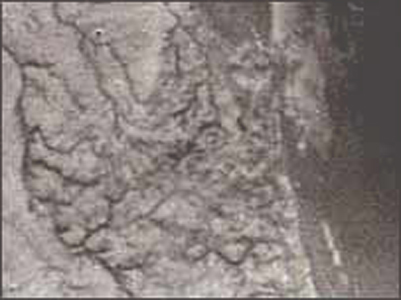 |
| This picture of the surface shows the orangy colour caused by its marmelade-colour cloud cover. What looks like rounded boulders in the foreground are about 15 cms across and possible more like icy snowballs, since it is so cold that ice gows through more phase changes than it would on Earth and is more like a rock. The ground under Huygens is soggy indicating recent rain (but of methane). | 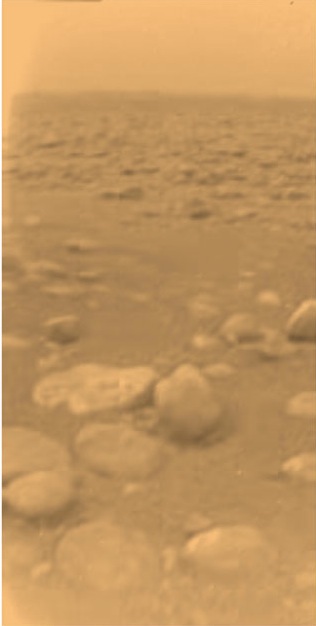 |
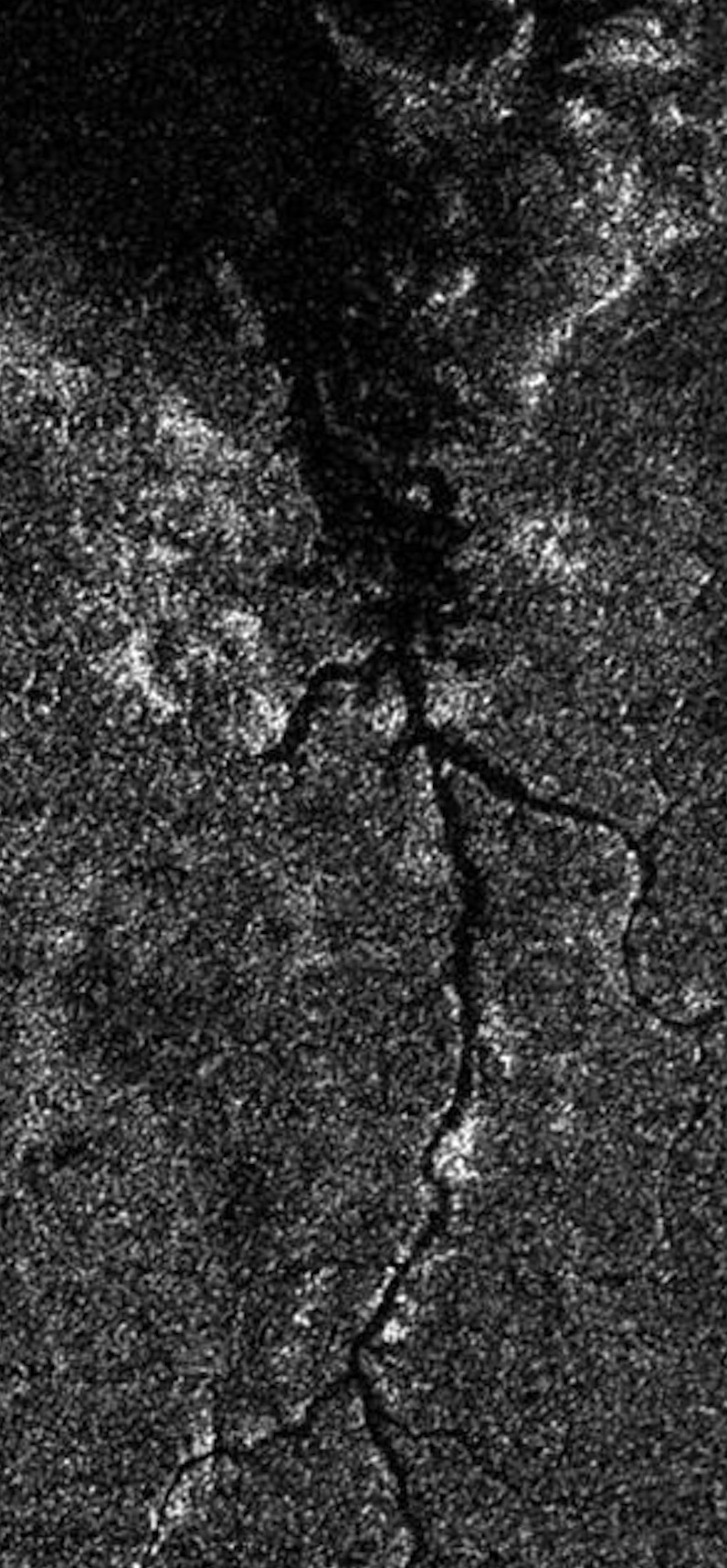 Picture shows a river on Titan taken with radar from Cassini. It is not water in the rivers but ethane. Cassini continues to survey Titan on its rounds. It has discovered that Titan is covered with colossal dunes - not the same sort of sand as on Earth though.
Picture shows a river on Titan taken with radar from Cassini. It is not water in the rivers but ethane. Cassini continues to survey Titan on its rounds. It has discovered that Titan is covered with colossal dunes - not the same sort of sand as on Earth though.
Latest radar mapping of strips across Titan have revealed apparently almost Earth-like landscape, but formed with methane rather than water. The weather on Titan which has helped to form the rivers and lakes is being studied. So far Titan seems prone to drizzling methane, but heavier rain must have formed the water features on its landscape. The clouds are also methane.
Surveys of images taken 2007 and 2009 has shown the lakes changing in size as lakes do on Earth.
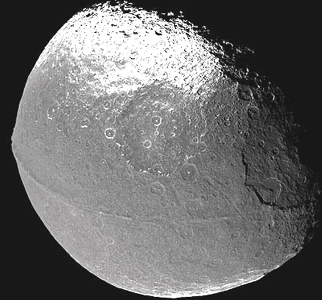 discovered in 1671, is 718±8 kilometres in radius with a density of 1.21. It is half one colour, half another. Its leading hemisphere is dark red in colour, with an albedo of 0.1. (The albedo is the reflected light, total reflection of light, that is the maximum brightness possible, is 1). The trailing hemisphere of Iapetus is light coloured with an albedo of 0.5. This bright side is heavily cratered. The dark floors of craters near the edge of the pale side indicate the dark red of the other side may be the main colour of the whole body, not a coating collected from space. Information from Cassini shows that Iapetus is divided all around its equator by a mountainous ridge in some places about 13 km high. Further research helped by the Cassini mission has shown that Iapetus is much as it was soon after the formation of the solar system. Its bulging midsection with a ridge of mountains along its equator, and slow spin rate may be caused by heating from long-extinct radioactive elements present when the solar system was born. Names of features on Iapetus are taken from the Mediaeval French epic Chanson de Roland.
discovered in 1671, is 718±8 kilometres in radius with a density of 1.21. It is half one colour, half another. Its leading hemisphere is dark red in colour, with an albedo of 0.1. (The albedo is the reflected light, total reflection of light, that is the maximum brightness possible, is 1). The trailing hemisphere of Iapetus is light coloured with an albedo of 0.5. This bright side is heavily cratered. The dark floors of craters near the edge of the pale side indicate the dark red of the other side may be the main colour of the whole body, not a coating collected from space. Information from Cassini shows that Iapetus is divided all around its equator by a mountainous ridge in some places about 13 km high. Further research helped by the Cassini mission has shown that Iapetus is much as it was soon after the formation of the solar system. Its bulging midsection with a ridge of mountains along its equator, and slow spin rate may be caused by heating from long-extinct radioactive elements present when the solar system was born. Names of features on Iapetus are taken from the Mediaeval French epic Chanson de Roland.
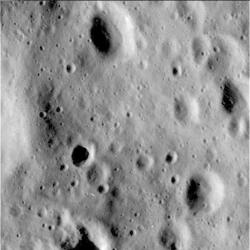 discovered in 1672 is 764±4 kilometres in radius with a density of 1.33. It is made of rock and ice, with slightly more ice than rock. It has a high albedo of 0.6 so it must have a fairly clean icy surface. At the low temperatures this far from the Sun, ice can be frozen very hard - so that it can be frozen into a state when it behaves more like a kind of rock. The icy surface of Rhea is heavily pocked with impact craters. This indicates that there has been little geological activity in recent times in Rhea's history. Early in Rhea's history, there was geological activity resulting in large troughs, faults or chasms, like the Kun Lun Chasma. The names of features on Rhea's surface are all taken from the world's creation myths. More on Rhea.
discovered in 1672 is 764±4 kilometres in radius with a density of 1.33. It is made of rock and ice, with slightly more ice than rock. It has a high albedo of 0.6 so it must have a fairly clean icy surface. At the low temperatures this far from the Sun, ice can be frozen very hard - so that it can be frozen into a state when it behaves more like a kind of rock. The icy surface of Rhea is heavily pocked with impact craters. This indicates that there has been little geological activity in recent times in Rhea's history. Early in Rhea's history, there was geological activity resulting in large troughs, faults or chasms, like the Kun Lun Chasma. The names of features on Rhea's surface are all taken from the world's creation myths. More on Rhea.
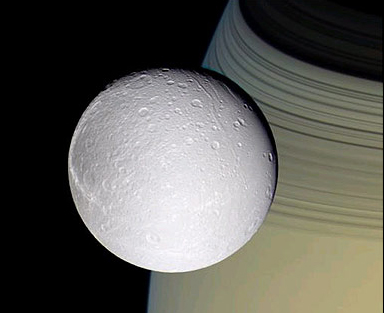 was discovered in 1684. Its radius is 559±5 kilometres, and density 1.44. It has a bright icy surface, albedo 0.5. Its leading hemisphere is brighter than its trailing hemisphere. There are three main types of terrain - heavily cratered, lightly cratered plains, and smooth plains with few craters. As geological activity obliterates earlier features such as craters, a heavily cratered surface indicates an older surface and the comparative age of other features can be ascertained by the partial obliteration of earlier features. Dione had active volcanism up to about two and a half thousand million years ago, and changes have continued to occur on its surface. There are active tectonic faults, which look like long pale wispy streaks in the Voyager 2 pictures. From Cassini in December 2004 these are seen to be bright ice cliffs created by tectonic fractures. The names of Dione's features are taken from Virgil's Aeneid.
was discovered in 1684. Its radius is 559±5 kilometres, and density 1.44. It has a bright icy surface, albedo 0.5. Its leading hemisphere is brighter than its trailing hemisphere. There are three main types of terrain - heavily cratered, lightly cratered plains, and smooth plains with few craters. As geological activity obliterates earlier features such as craters, a heavily cratered surface indicates an older surface and the comparative age of other features can be ascertained by the partial obliteration of earlier features. Dione had active volcanism up to about two and a half thousand million years ago, and changes have continued to occur on its surface. There are active tectonic faults, which look like long pale wispy streaks in the Voyager 2 pictures. From Cassini in December 2004 these are seen to be bright ice cliffs created by tectonic fractures. The names of Dione's features are taken from Virgil's Aeneid.
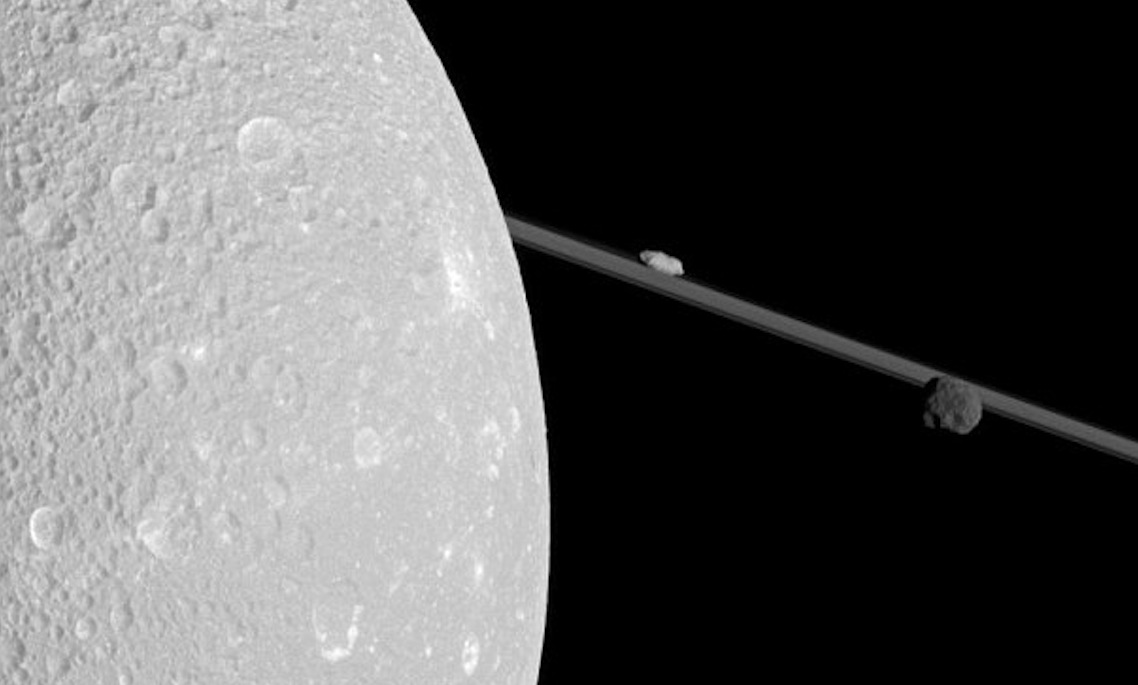
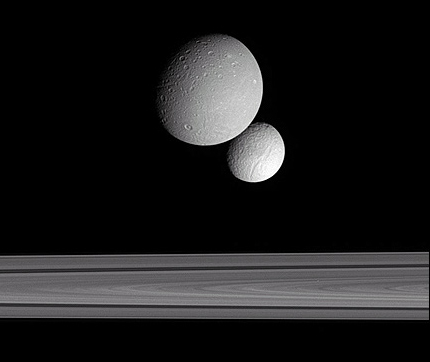 Dione, Tethys and Saturn's rings from Cassini
Dione, Tethys and Saturn's rings from Cassini
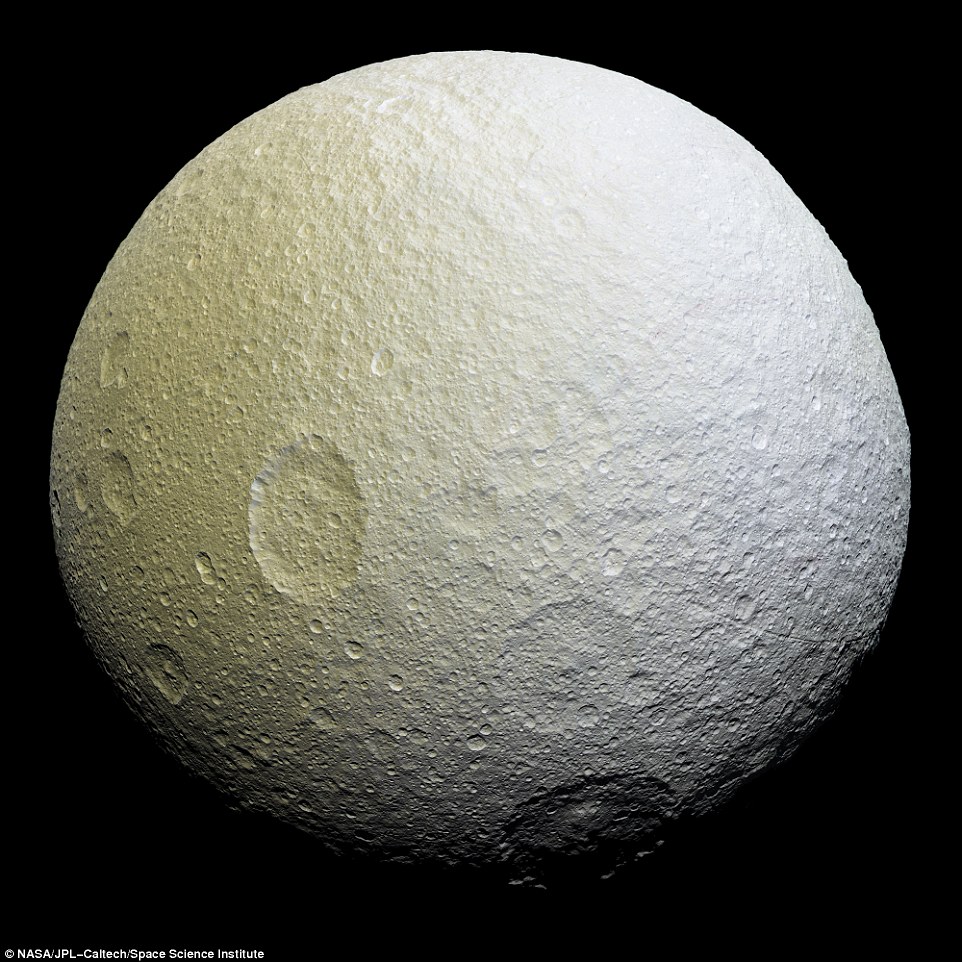 was discovered in 1684. It is 524±5 kilometres in radius, with a density of 1.26. It has two very impressive surface features. It is encircled by a mighty chasm, the Ithaca Chasma, which is 2.500 kilometres long and up to 100 kilometres wide, and about 3 kilometres deep. In the centre of this is its possible cause, the remains of the giant Odysseus crater, which has long since settled (relaxed) into the surface terrain. The body causing this massive crater landed a long time ago, and nothing much has happened to Tethys since.
was discovered in 1684. It is 524±5 kilometres in radius, with a density of 1.26. It has two very impressive surface features. It is encircled by a mighty chasm, the Ithaca Chasma, which is 2.500 kilometres long and up to 100 kilometres wide, and about 3 kilometres deep. In the centre of this is its possible cause, the remains of the giant Odysseus crater, which has long since settled (relaxed) into the surface terrain. The body causing this massive crater landed a long time ago, and nothing much has happened to Tethys since.
Enceladus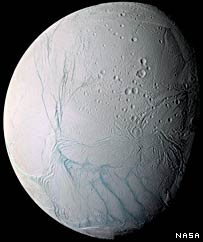 |
|---|
| Enceladus was discovered in 1789. It has a radius of 251±5 kilometres and density of 1.24. It is in 2:1 resonance with Dione, so they have a tidal effect on each other. Enceladus has a very mixed terrain, at least five different types of scenery. Cratered material is divided and covered by great curved grooves and flows of material which may have erupted from them. Straight grooves at angles to each other by these sites, may be fracture faults. In July 2005, Cassini skimmed just 175 km above the surface and saw white boulders scattered on the surface about 10m.-20m. across. (see picture). They do not fill the cracks so they appear to have formed earlier. The surface is very bright - nearly 1, so it must be covered by recent icy frost and other indications have been found recently by Cassini that Enceladus is geologically active with hot eruptions still occuring under its icy surface which are caused by tidal heating. There is a water vapour atmosphere. It may not be very old, it is thought it may have accreted into a solid body about three thousand million years ago. That is one and a half thousand million years after the formation of most of the bodies in the solar system. It is thought the history of Enceladus is connected to Saturn's E-ring as this has maximum concentration at about 230,000 kilometres from the centre of Saturn, which coincides with the orbit of Enceladus. |
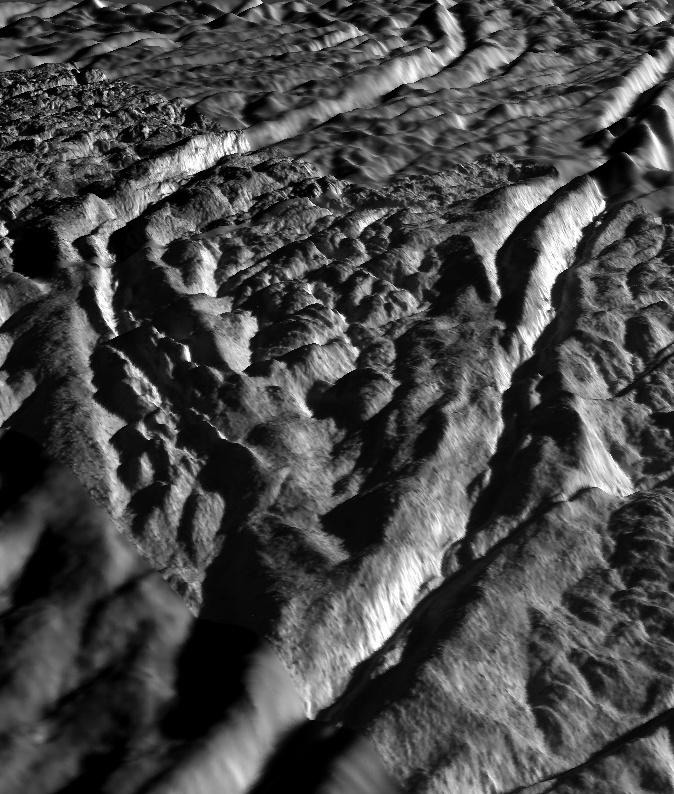
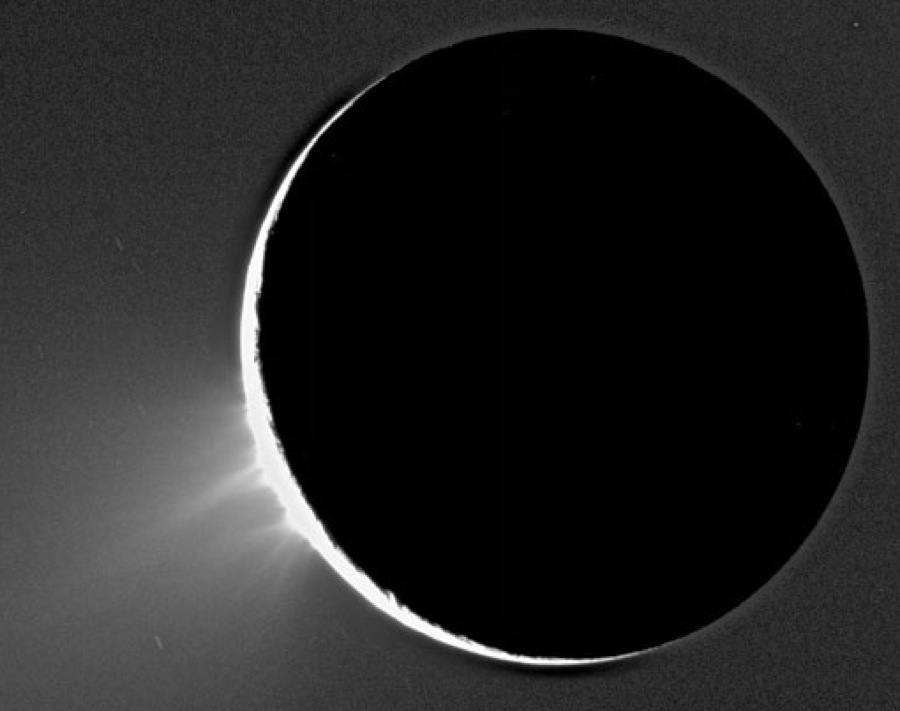 |
|
Cassini showed that from fissures in the south pole a plume of water spumes out forming a vapour trail which becomes part of the E-ring. There are organic traces in this warm southern region. The picture shows a closer view of the area of troughs emitting vapour - this is Bagdad Sulcus, which is in that area. More about these discoveries. |
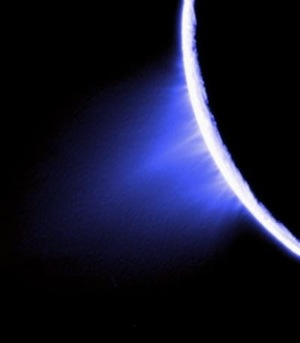 Salty ice particles stream from Enceladus indicating salty ocean. Salty ice particles stream from Enceladus indicating salty ocean. |

|
| Features on Enceladus are named from Burton's version of The Arabian Nights. |
|
|
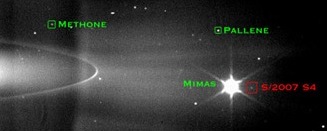
S/2007 S 4, discovered in mid 2007, orbits Saturn between the paths of Methone and Pallene.
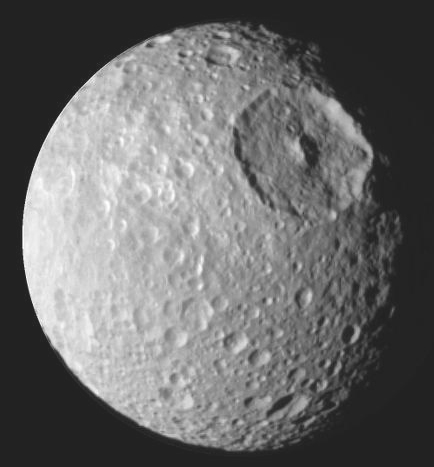 was discovered in 1789. It is 197±3 kilometres in radius, with a density of 1.17. It is heavily cratered. One crater, called Herschel after William Herschel who discovered Mimas, is absolutely huge in comparison with the size of the planetary body - 130 kilometres in diameter The impact of an object large enough to cause a crater that size must have come near to breaking up the planet, giant cracks cross the surface. Apart from Herschel, other features are named from Mallory's L'Morte d'Arthur.
was discovered in 1789. It is 197±3 kilometres in radius, with a density of 1.17. It is heavily cratered. One crater, called Herschel after William Herschel who discovered Mimas, is absolutely huge in comparison with the size of the planetary body - 130 kilometres in diameter The impact of an object large enough to cause a crater that size must have come near to breaking up the planet, giant cracks cross the surface. Apart from Herschel, other features are named from Mallory's L'Morte d'Arthur.
Hyperion |
|
|---|---|
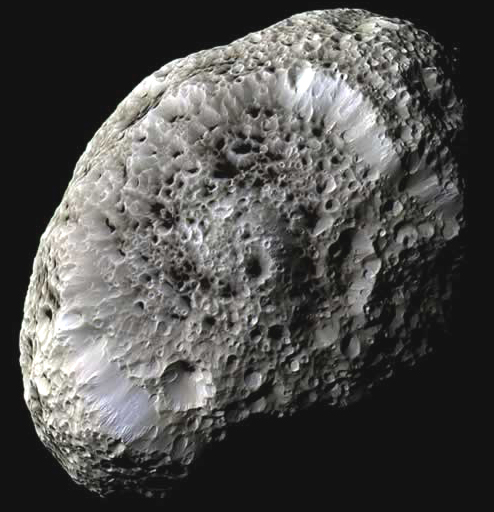 | Hyperion was discovered in 1848. It is a dark reddish colour, and battered by so many craters it looks spongy. Recent fly-pasts have shown that Hyperion is indeed spongy with a density only half that of water. Its surface has water ice mixed with frozen carbon-dioxide, and more complex hydro-carbons. Tidal forces from Saturn and Titan and its odd shape give it a strangely chaotic orbit and rotation. (See Ian Stewart's book "Does God Play Dice?" for more on Hyperion's orbit.) You can see a quicktime movie of Hyperion's tumbles taken from Cassini. |
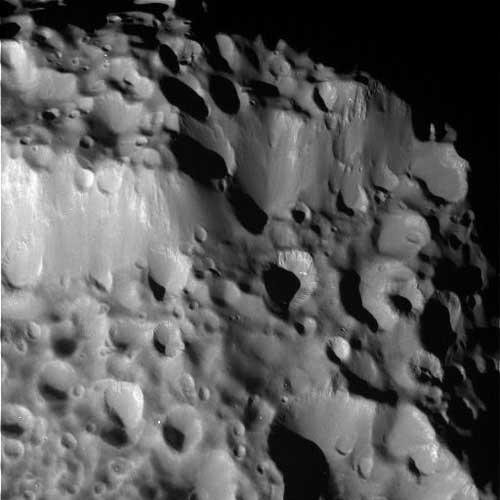 | Pictures from Cassini, show a tortured world, riven by craters and girdled by a giant cliff face tens of kilometres high. |
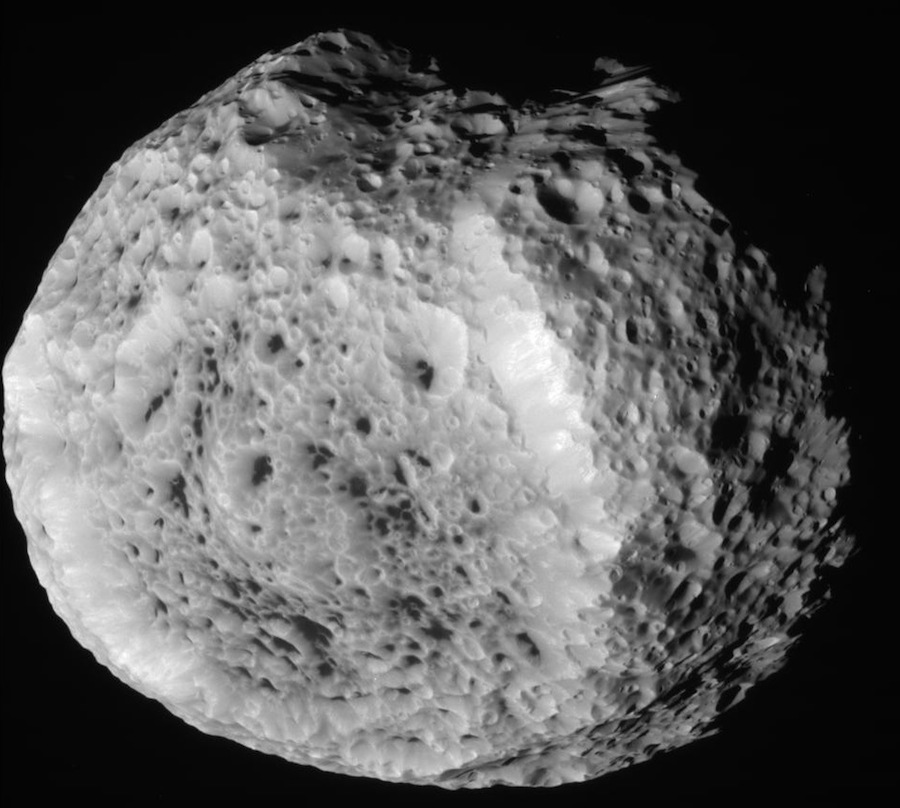 | Hyperion taken by Cassini 24th August 2011. |
Prometheus and

Epimetheus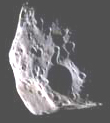 Janus |
| Both found by Voyager in 1980, have ancient craters, and are in the same orbit, but when they catch up with each other, they do not collide as their gravitational fields cause them to bounce off each other without touching, and they swap orbits about every four years. They are responsible for a wavy pattern in Saturn's rings. They are mostly water ice and rubble. At 116 kilometres across, Epimetheus is slightly smaller than Janus at 181 kilometres across. |
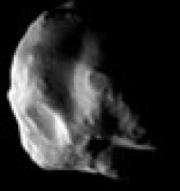
but red
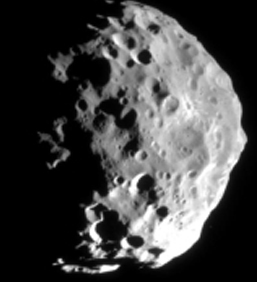 was discovered in 1898. It is the farthest out from Saturn of all its orbiting satellites and goes round it the wrong way to the others. Closer investigation on the Cassini mission confirmed as suspected that Phoebe is probably a captured Kuiper belt object, and is very cold (minus 163 degrees Celsius) with a much battered, dirty icy surface. Phoebe has a density consistent with that of the only Kuiper Belt objects for which densities are known. Phoebe's mass, combined with an accurate volume estimate from images, yields a density of about 1.6 grams per cubic centimeter (100 pounds per cubic foot), much lighter than most rocks but heavier than pure ice, which is about 0.93 grams per cubic centimeter (58 pounds per cubic foot). This suggests a composition of ice and rock similar to that of Neptune's moon Triton and Kuiper belt objects.
was discovered in 1898. It is the farthest out from Saturn of all its orbiting satellites and goes round it the wrong way to the others. Closer investigation on the Cassini mission confirmed as suspected that Phoebe is probably a captured Kuiper belt object, and is very cold (minus 163 degrees Celsius) with a much battered, dirty icy surface. Phoebe has a density consistent with that of the only Kuiper Belt objects for which densities are known. Phoebe's mass, combined with an accurate volume estimate from images, yields a density of about 1.6 grams per cubic centimeter (100 pounds per cubic foot), much lighter than most rocks but heavier than pure ice, which is about 0.93 grams per cubic centimeter (58 pounds per cubic foot). This suggests a composition of ice and rock similar to that of Neptune's moon Triton and Kuiper belt objects.
Latest discoveries about Saturn and its moons from Cassini, including video tours - of Titan etc.

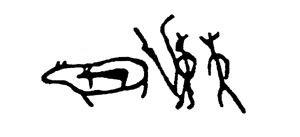 |